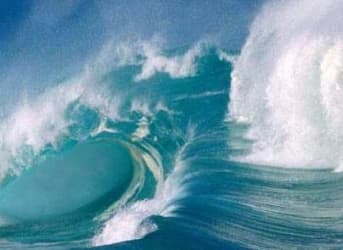What’s the one thing that could meet around a quarter of the United States’ -- and three-quarters of the United Kingdom’s -- energy needs, but is largely being ignored by investors? Hint: It’s big and blue and covers more than 70 percent of the planet.
We’re talking about the ocean. And many are the companies who have become frustrated in their attempts to develop its power for human use. While other green energies, such as wind and solar, have received tremendous attention and investiture, tidal and wave energy is, as of yet, untapped.
Engineers have been racking their brains for centuries, knowing that the power of the ocean is an obvious source of potential energy. But harnessing that power is a much more difficult prospect than capturing energy from the wind and Sun. As George Hagerman, a research associate at Virginia Tech University’s Advanced Research Institute notes, “With wind, you’re harnessing the energy as a function of the speed of the wind. In wave energy, you’ve not only got the height of the wave, but you’ve got the period of the wave, so it becomes a more complicated problem.”
But while the world has yet to see the establishment of a large-scale, wave-fueled commercial power station, there have been notable advancements in the field. In September 2008, off the coast in Portugal, the Aguçadoura Wave Farm became the first of its kind. It used Pelamis converters to capture the surface energy of waves and harness it for electricity. Unfortunately, due to technical problems, the facility was shut down only two months later.
But from failure comes experience. These five companies are poised to try and become ocean-power pioneers that succeed:

Credit inhabitat.com
1. Aside from being a delicious mollusk, the oyster inspired a Scottish company named Aquamarine Power to create a shape that, they say, is efficiently capable of fueling an on-shore base. This base will have the capacity of powering thousands of homes each day. According to inhabitat.com, “The Oyster uses hydraulics to transfer high-pressure water to shore, where it’s then converted to electricity, essentially using wave power to fuel an onshore hydroelectric plant. Once activated by a wave’s motion, an underwater oscillator equipped with pistons pumps water through a pipeline to shore. Onshore generators then convert the water into electricity.” This option is nice because the main mechanisms are onshore, making repairs simpler and the system more consistent. Recent technological improvements can “make electricity whether the segments are moving up and down, from side to side, or in any other direction,” increasing efficiency at turning waves into energy.

Credit: popularmechsnics.com
Related Article: Five Crazy New Forms Of Energy That Just Might Work
2. The Pelamis Wave Energy Converter is also known as the “sea-snake.” The Pelamis uses giant cylinders and hydraulic joints to pump oil throughout the hydraulic motors. The new design can “make electricity whether the segments are moving up and down, from side to side, or in any other direction,” the company says. They claim that their design can increase the efficiency of converting waves into energy. Each “snake” is about six hundred feet long and provides enough power to keep the lights and power going in about 500 homes for a year.

Credit: popularmechanics.com
3. Oceanlinx is a company trying to provide a smaller, lighter, innovation for wave-harnessing technology. The “greenWAVE consists of an underwater tunnel that opens on a cabin full of air that sits above the waterline. At the top of the cabin is a small hole with a turbine. As an incoming wave floods the device with water, it compresses the air inside the cabin, making it rush out the air vent. When the water recedes, the falling water creates a vacuum inside the chamber. That makes the cabin suck in air from outside.” The greenWAVE is relatively inexpensive and can survive harsh storms.

Credit: U.S. Airforce
4. “The Terminator” – an airplane-inspired turbine from the U.S. Air Force – is showing promising early results. It hasn’t yet been tested in the open ocean, but in lab tests it could harness as much as 99 percent of a wave’s energy – almost twice what other inventions have achieved.
ADVERTISEMENT

Credit: Ocean Power Technologies
5. Ocean Power Technologies describes its Autonomous PowerBuoy as having a “moving float that's 5 feet in diameter by 5 feet tall and a 25-foot-tall spar anchoring it. When the float bobs up and down on the wave, it tugs on the spar. That stretching gets translated into electricity by a rotary motor and generator.” In February, Lockheed Martin announced that it had signed a contract to develop a 62.5-megawatt peak power wave energy generation project off Victoria, Australia, calling it a "significant step toward making ocean energy commercially available." The facility, which will use the Autonomous PowerBuoy, will be the world's largest wave energy project.
The wave power industry is still the “wild west” of technological entrepreneurship. While this unbridled spirit comes with its own challenges, it’s this same dynamic and ‘anything goes’ culture that’s so essential for developing innovative solutions. But no invention can get off the ground without investment; without billions of dollars of capital, this sector of the renewable market can’t take off the way solar and wind have. If any of these companies demonstrate the potential to produce energy on a large scale, however, the money will likely follow.
By Amy Gleich of Oilprice.com



















Will you be doing a report on turbines driven by ocean currents?
An experimental turbine is under development in my own backyard: Admiralty Inlet, Puget Sound, WA state -- so I'm very interested!
I wish to ask whether your organization can assist us to build the dynamo we want to use for the development of Tidal Technology we are trying to build in Nigeria or can you build the prototype for us?
Thanks.
Yours faithfully,
Abiodun.A.Adebanjo